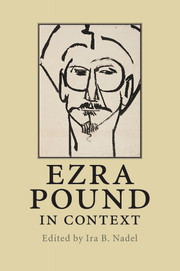Book contents
- Frontmatter
- Contents
- Notes on contributors
- Acknowledgements
- Chronology
- List of abbreviations and note on references to The Cantos
- Introduction
- Part I Biography and works
- Part II Historical and cultural context
- 16 The classics
- 17 Provençal and the troubadours
- 18 Dante and early Italian poetry
- 19 America
- 20 Venice
- 21 London
- 22 Paris
- 23 Rapallo and Rome
- 24 Pisa
- 25 Imagism
- 26 Vorticism
- 27 Music
- 28 Visual arts
- 29 Confucius
- 30 The Orient
- 31 Little magazines
- 32 Publishing and publishers
- 33 Modernism
- 34 Fascism
- 35 Anti-Semitism
- 36 Gender and sexuality
- 37 Race
- 38 Travel
- Part III Critical reception
- Further reading
- Index
17 - Provençal and the troubadours
Published online by Cambridge University Press: 05 July 2014
- Frontmatter
- Contents
- Notes on contributors
- Acknowledgements
- Chronology
- List of abbreviations and note on references to The Cantos
- Introduction
- Part I Biography and works
- Part II Historical and cultural context
- 16 The classics
- 17 Provençal and the troubadours
- 18 Dante and early Italian poetry
- 19 America
- 20 Venice
- 21 London
- 22 Paris
- 23 Rapallo and Rome
- 24 Pisa
- 25 Imagism
- 26 Vorticism
- 27 Music
- 28 Visual arts
- 29 Confucius
- 30 The Orient
- 31 Little magazines
- 32 Publishing and publishers
- 33 Modernism
- 34 Fascism
- 35 Anti-Semitism
- 36 Gender and sexuality
- 37 Race
- 38 Travel
- Part III Critical reception
- Further reading
- Index
Summary
Pound, in the teens and 1920s, understood the literary logic of modernism, with its poetics of difficulty and allusiveness, more clearly than any of his contemporaries. He pushed his insights further, into an extreme, enormous, all-but-unreadable book – the “Cantos”….
By the age of fifteen Ezra Pound “already knew, apparently, pretty much what he wanted to do – that by the time he was 30 he ‘would know more about poetry than any man living’” (Moody, 13). He first read Browning's Sordello in 1904. “I began to get it on about the 6th reading,” he would write to his father, and he thought he might be able to model his own long poem on Browning's difficult epic about the Italian adventurer who became a troubadour. Within a year he found a way to study Provençal. In spring term of 1905, the last trimester of his senior year at Hamilton College, he was introduced to the language by Professor William P. Shepard, cementing a relationship that would last as long as Shepard lived. Pound and Bill, as Pound called him, read H. J. Chaytor's Troubadours of Dante, which included poems by Sordello as well as Bertran de Born, Arnaut Daniel, and others whom Pound would continue to read for years. In May the Hamilton Literary Magazine published his version of a text in Latin and archaic Provençal that he called the “Belangal Alba.”
After graduating from Hamilton, Pound returned to the University of Pennsylvania (where he had spent his freshman and sophomore years), near his family's home in the Philadelphia suburb of Wyncote. In 1905–6, as a student in the Master's program in Romanic Languages, he studied almost exclusively with the Hispanist Hugo Rennert, working on Spanish (Old Spanish, Spanish Drama, Spanish Literature), Old French, Italian (Petrarch), and more Provençal. He bought a copy of Carl Appel's Provenzalische Chrestomathie (Provençal Anthology) in the second edition (1902) and dated it 1905, presumably in the fall when he began his work with Rennert.
- Type
- Chapter
- Information
- Ezra Pound in Context , pp. 181 - 191Publisher: Cambridge University PressPrint publication year: 2010

